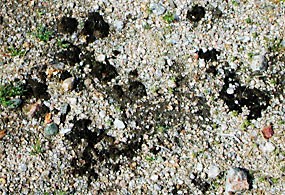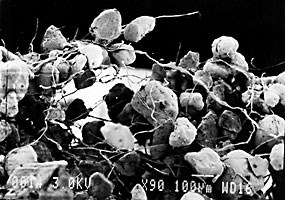
Living soil crusts are found throughout the world, from the hottest deserts to polar regions. In the desert, these crusts are dominated by cyanobacteria (blue-green algae), but also include lichens, mosses, green algae, microfungi, and bacteria. 
These sheaths build up in the soil over long periods of time, up to 15 cm deep in some areas. Not only do they protect the soil from blowing away; they also absorb precious rainfall (reducing flash flood runoff) and provide a huge surface area for nutrients to cling to. They contribute nitrogen and organic matter to ecosystems which is critical in deserts where resources are few and far between. Unfortunately, many human activities are incompatible with these fragile crusts. The fibers that offer stability to the soil surface are no match for the boot of a hiker nor the weight of a tire. Crushed crusts contribute less nitrogen and organic matter to the ecosystem; under the best circumstances, a thin veneer may return in five to seven years! So now what? Well, the best thing we can all do is try not to love our desert to death. Stay on established trails, and keep your vehicle on approved roads within the park. If you must walk through an area thick with crusts (you may see them as lumpy black bumps on the ground), walk in single file to destroy as small an area as possible. The desert will thank you for this in years to come, with bountiful wildflower displays in the crusted areas, as well as with land kept in place and a healthy ecosystem. by Vegetation Specialist Jane Rodgers |
Last updated: February 28, 2015
